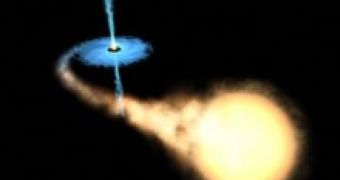The most massive objects in the sky are black holes and neutron stars. They both are sometimes seen in the company of other stars - the material from these stars is being absorbed by the black hole or by the neutron star.
Astronomers have now discovered a way to determine the position of black hole's event horizon - the surface beyond which not even light can escape the gravity. The black hole's event horizon is by definition unseen. However, the comparison between black holes and neutron stars can make a difference.
Both black holes and neutron stars are end points in the life of very massive stars (at least 10 times more massive than our Sun). When a massive star runs out of fuel it collapses under its own gravity. If the star has about 10 to 25 solar masses, the star collapses into an extremely dense sphere about 15 kilometers across. Such a sphere is called a neutron star. The composition of a neutron star is a liquid of neutrons and electrons, and the surface is thought to be solid. (Regular stars are mostly a gas of protons and electrons.) The reason why the neutron star does not collapse any further is that neutrons repel each other via nuclear force. (In regular stars, protons repel each other due to electric force. The electric force is much stronger than nuclear force and this is why regular stars are gases and not liquids.)
However, if the star is over 25 times more massive than our sun, the magnitude of gravitation will exceed the nuclear force between the neutrons and the core will collapse to a point of infinite density with no surface. This star has collapsed into a black hole. Within a boundary of about 80 kilometers from the black hole's center in all directions, gravity is so strong that not even light can escape its pull. This boundary is the theoretical event horizon. Neutron stars have a hard surface and no event horizon.
Black holes and their neutron star cousins are sometimes located in binary systems, orbiting a relatively normal star companion. Gas from these stars, lured by gravity, flows toward the compact object. This process, called accretion, releases large amounts of energy, predominantly in the form of X-rays, as gas moves quickly and heats to high temperatures. Gas can accumulate on a neutron star surface. When conditions are ripe, the gas will ignite in a thermonuclear explosion that is visible as a one-minute event called a type I X-ray burst. The suspected black holes behave as if they had no surface and were located behind event horizons.
The idea of using the absence of X-ray bursts to confirm the presence of event horizons in black holes was proposed in 2002 by Ramesh Narayan and Jeremy Heyl of the University of British Columbia in Vancouver. "It was a very simple but powerful idea," said Narayan. "Type I bursts are easy to identify, and we can compare burst statistics with the quantitative predictions of our burst model for a variety of compact objects with a hard surface. With this new analysis, the argument for black hole event horizons has become much stronger."
Using the Rossi Explorer, a team from MIT and Harvard-Smithsonian Center for Astrophysics in Cambridge observed all of the transient sources that have appeared in the X-ray sky over the last nine years. In all of these sources, a suspected neutron star or black hole accretes gas from a companion star in a tight binary system.
"Event horizons are invisible by definition, so it seems impossible to prove their existence," said Ron Remillard. "Yet by looking at objects that pull in gas, we can infer whether that gas crashes and accumulates onto a hard surface or just quietly vanishes. For the group of suspected black holes we studied, there is a complete absence of surface explosions called X-ray bursts. The gas that would fuel such bursts appears to vanish."
Ron Remillard of the MIT Kavli Institute in Cambridge, Mass., led the analysis and discusses his team's result today at a press conference at the 207th meeting of the American Astronomical Society in Washington. His colleagues are Dacheng Lin of MIT, and Randall Cooper and Ramesh Narayan of the Harvard-Smithsonian Center for Astrophysics in Cambridge.
Image Credits: NASA - artist's impression of a black hole with a closely orbiting companion star

 14 DAY TRIAL //
14 DAY TRIAL //